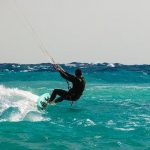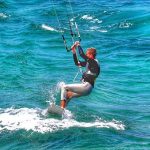So you have mastered the basics of kiteboarding and you are now ready to move onto more advanced tricks. Although these tricks may seem daunting at first, they can be quickly mastered with practice. Just be careful, as these tricks can be dangerous if performed incorrectly.
This is a guide to learning simple and complex freestyle kiteboarding tricks, with 10 of the most fun and visually appealing tricks explained in detail.
Freestyle Kiteboarding: 3 Tricks That Will Make You High
Kite Loop
A kite loop is when the kite goes backwards in a loop because the rider pulled on the back of the bar. This action can be strong because it goes against the forward force.
Kite loops should not be confused with under-turns or down loops.
Your Board Needs
You need to err on the side of caution, land with your weight over your front foot and keep the kite low to avoid any surprises. In order to do a kite loop, you need to be able to jump and land well.
If you’re used to landing quickly and confidently, and you’re good at keeping your board pointing downwind, you have a good chance at being successful. Kite loops generate extra power that pulls you downwind, so landing on your feet is essential.
Be cautious, land with your weight over your front foot, and keep the kite low to avoid any surprises.
Get Your Head in the Game
After you have mastered landing the kite confidently, the looping part should be much easier. Remember to take your time learning this move and do not try to rush it.
If you have already learned how to do under-turns, then you should have no problem with this since you know that as long as you keep pulling the kite, it will keep turning.
12 O’clock Rock
The best time to kite loop is either midday or midnight, when the power is at its strongest. You should always steering your kite up to the haven of 12 before tugging at the bar to create the loop, as this will generate the most power and give you the most control.
When you hold your kite straight up and pull strongly on one side of the bar, your kite will turn in a tight circle quickly. It reacts quickly because you are hanging below it, which creates tension in the lines and makes the kite respond quickly.
Another advantage is that the kite is high up, so it would take something unfortunate to happen to get it down low. If you were to start your loop with the kite at either 10 o’clock or 1 o’clock, the kite would be lower and you would get more of a yank.
Therefore, where you start the kite loop affects how much you get.
Kites
I’m not looking to start a fight, but almost all modern kites will turn on a dime, whether they’re bow, hybrid, or C kites. The argument that “I’m a man because I can loop a C kite” died when the designers made them turn, which was a long time ago.For “man points,” you’ll leave the kite behind you and pull.
The more forcefully you pull on the kite’s strings, the smaller the looping radius becomes, and consequently, the less power you generate. If you steer the kite around in a gentle, large loop, you can expect to get a lot of power, and then you’ll still need enough height to complete the loop.
To keep up in this brisk business, you must keep your kite trimmed in so it will keep turning. This is vital on bows.
Move your back hand down the bar to get more power, and when you pull, push with your front hand to make sure there is a reaction.
Timing & Balance
The best way to learn to kite loop is to leave the big pull until you feel yourself descending. This way you’ll have less forward momentum, less power in the kite, and more chance of controlling it.
You also need to anticipate from where the pull will come to keep well balanced when it does. Although you may expect the pull to come from downwind of you, because the kite is being steered back it will actually pull you back as well.
If you are trying to spot your landing, looking forwards as the kite pulls back you could well get out of shape. As a rough guideline, once you pull, turn your head slightly so that your nose is pointing towards your backhand.
Once the power has gone you can worry about where you’ll be landing.
L-Plates
Now that you’ve perused through the scripture just remember:
You should want just enough power to get you off the water for a gentle jump. A height of 1 meter would be adequate.
You should change the direction of the kite after it takes off so that it is flying at 12 o’clock. This way you can make it loop with less power.
You should pull as hard as you can with your backhand until the kite starts to rise and turn 360°.
To generate more leverage, move your back hand down the bar. Use both hands to steer the bike, with the back hand pulling and the front hand pushing.
To make the kite turn in a tight arc, keep the bar in the sweet spot and don’tsheet out.
To anticipate the pull, look slightly back over your backhand.
Land with the board facing downwind.
Top Tips
It is okay if you land before the kite has looped when you are learning. As long as the kite has turned enough to be going forward, you will be fine. After that, jump a little bit higher and start pulling the kite earlier.
The most important thing to remember when kite looping is to keep pulling on the kite. It can be tempting to let go when you see the kite falling, but as long as it keeps rotating, you will be fine.
Back Roll (aka Back Loop)
The Back Roll/Loop is the first and easiest trick for a beginner freestyle kiteboarder to learn. Although it is relatively simple to master, doing it with style requires a bit of work.
Choose a windy day so you can focus on your body spinning instead of working the kite. A wind speed of about 15 knots is best to start with, since the mistakes you make will not be as drastic.
The following skills are recommended before taking this class: being able to do a basic jump, edge aggressively, ride without looking at your kite, fly your kite with your hands in the center of the bar, and relaunch your kite in all sorts of conditions.
Start by flying your kite slightly upwind, then pick up some speed by lowering it in the window. After that, move your kite back up slightly.
Keep your hands close to the center of your control bar so that it doesn’t move around too much.
Step 2: Push your board upwind by pressing on your heels and leaning back. Look in the direction you want to go.
Step 3: Get on your board and pop up to get it off the water. Keep your eyes looking over your front shoulder; this will naturally get your body to start rotating.
Step4: in order to help spin faster, bring your heels up close to your buttocks, and keep looking above your front shoulder to keep the rotation going.
Once you have completed Step 4, you will be positioned above the water with your body and head facing the opposite direction of where you are riding. Your body will continue to spin around in the direction you are riding.
As your body spins close to your original riding direction, you can turn your head and look towards your landing zone.
At the same time, you pull your bar down to send your kite towards the front half-window, giving it some power for a smoother landing.
You land on the water smoothly heading downwind and as soon as your board is back on the water and planning, you can carve upwind again.
If you don’t want to risk a kite loop, don’t pull too hard on your backhand. Keep your hands close to the depower line so that if you accidentally pull on the bar, you’ll just be sheeting in instead of building up speed and power.
Front Roll (aka Front Loop)
The next step is to try the Front Roll freestyle maneuver– it doesn’t seem much more difficult when you take a look at it.
Go out on a choppy day to make it easier to launch (you won’t have to work as hard with the kite) and make sure you’re slightly underpowered so you don’t hit the water too hard if you make a mistake.
The first step is similar to the Back Roll, you need to build up speed and move the kite up, then edge hard and sheet in while popping off the water. The difference with this move is that you need to rotate your body and turn your head back so you’re looking over your shoulder.
As you start taking off, you want to keep your body in a low andstable position. You should bend your front leg (relative to your initial riding direction) and extend your back leg. By doing this, you will have the rear tip of your board closer to the water than the front tip.
You also want to be looking over your rear shoulder (opposite your riding direction) so you can see what’s behind you.
Next, bend your knees and bring your feet closer to your backside while keeping your eyes glued to your back shoulder. As your body rotates, continue looking over your back shoulder.
As you finish your rotation, start extending your legs to slow the rotation and move the board back to the water. As with the Back Roll, use the front hand to pull on the bar and send the kite back.
Step 5: Touch down on the water in a full downwind direction, with some kite power for a gentle landing.
To avoid kite loops, keep your hands toward the center of the bar and make sure to send your kite into the half-window with enough force before landing.



